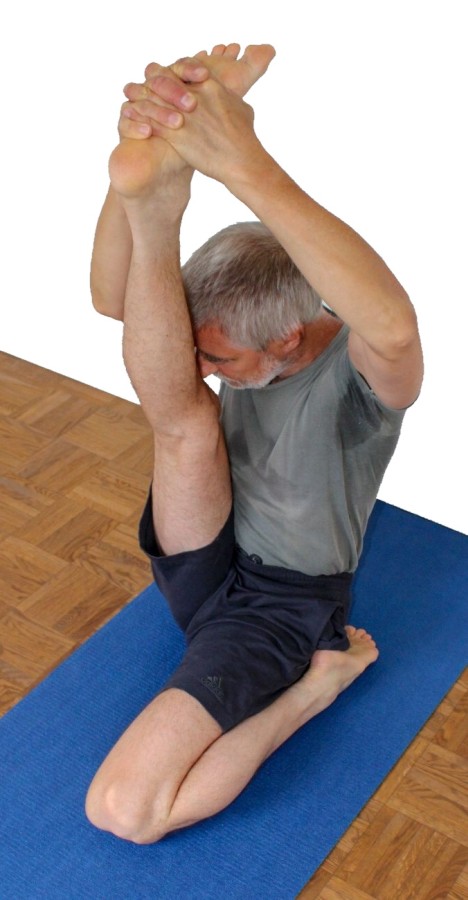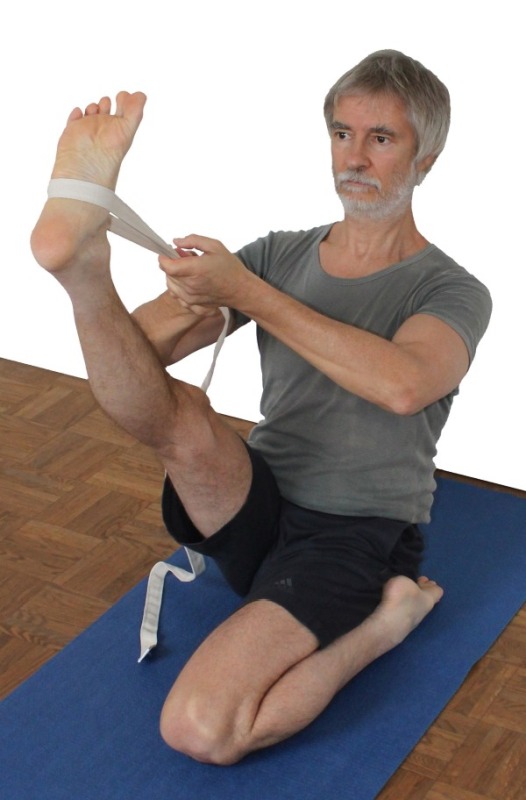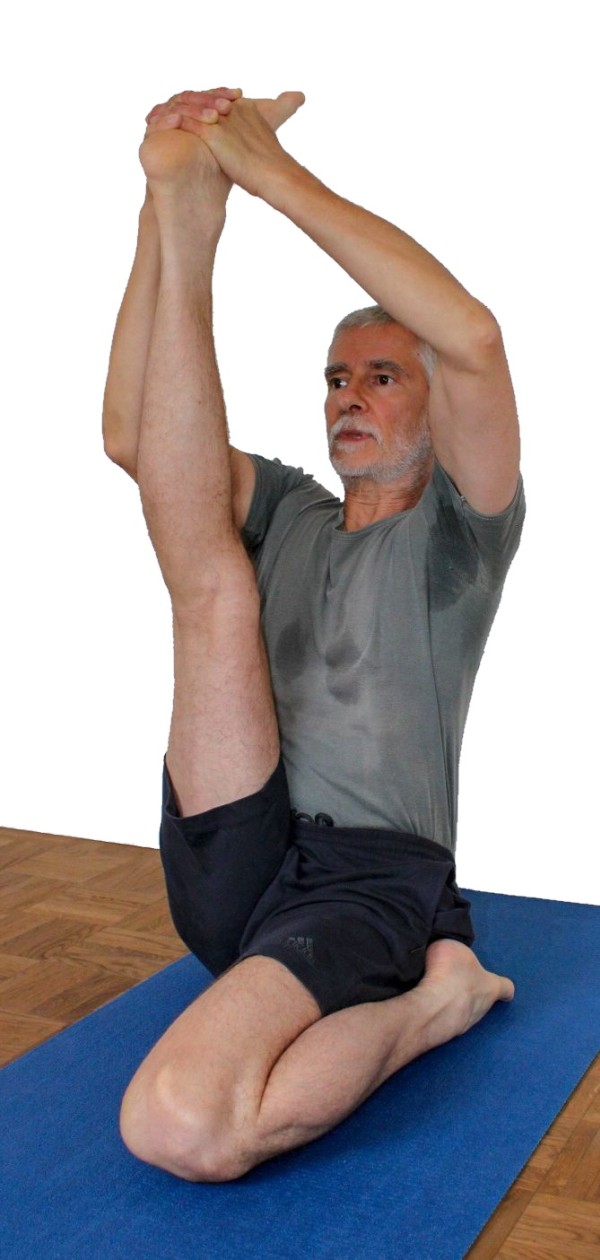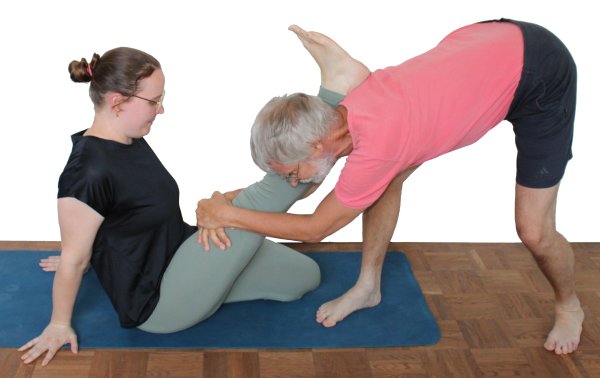yogabuch / asanas / krouncasana
Contents
krouncasana
„heron“

 instructions and details with working links as PDF for download/print
instructions and details with working links as PDF for download/print
Feedback: We’d love to hear what you think about this description, give us feedback at:
postmeister@yogabook.org
last update: 12/30/2018
Name: krouncasana
Trivial name: Heron
Level: B
- Classification: A
- Contraindication
- Effects of
- Preparation
- follow-up
- derived asanas
- similar asanas
- diagnostics
- Instruction
- details
- Variants
Classification
classic: seated posture
physiological: stretching of the hamstrings
Contraindication
Effects
- (721) Stretching of the hamstrings
- (811) Stretching of the quadriceps (monoarticular parts)
- (841) Stretching of the dorsiflexors of the ankle
- (851) Stretching the biarticular calf muscles (gastrocnemius)
Preparation
As krouncasana contains a virasana leg, all stretching preparations of the quadriceps are generally recommended:
However, the more important preparation is usually that of the hamstrings; extraordinary flexibility is required here:
- uttanasana and various more intense variations
- prasarita padottanasana
- hip opener 5 as a very effective stretch of the hamstrings that goes beyond uttanasana
- downface dog backwards against the wall with one leg raised („favorite winter warm-up pose“)
- pascimottanasana
- janu sirsasana
- tryangamukhaikapada pascimottanasana
- warrior 3 pose
- trikonasana
- parivrtta trikonasana
- parivrtta ardha chandrasana
- hasta padangusthasana
- supta padangusthasana
To achieve a little more awareness of the stretching of the back, the following poses are suitable:
- „desk“ variant of uttanasana
- rectangular uttanasana
- warrior 3 pose
- warrior 3 pose – variation „backwards against the wall“
- upavista konasana in the „pull on the feet“ variation
- upavista konasana in the „with block“ variation
- shoulderstand (sarvangasana), rectangular variation
- halasana
- paripurna navasana
- headstand variation „lower legs bent“ and rectangular headstand
Follow-up
If a cramp or tendency to cramp occurs in the rectus femoris during the pose, these poses help:
- supta virasana
- quadriceps stretch 1 on the wall
- quadriceps stretch 2 on the wall
- ardha supta krouncasana
Derived asanas:
Similar asanas:
Diagnostics (No.)
As in virasana (see there), we receive indications of knee problems of various kinds.
Excessive tension or low strength endurance in the back muscles will quickly become noticeable here.
- Excessive tension: will lead to a clear and increasing feeling of tension or cramping.
- Low strength endurance: will fatigue the back muscles and cause them to lose performance.
(603) Back/shoulder
Tension and shortening of the muscles between the spine and shoulder blade may lead to a strongly stretching or tearing irritating feeling.
(610) Dislocated vertebrae
lead to a one-sided, usually quite strong stabbing or tearing sensation, which usually radiates laterally from one vertebra.
(721)(724) Hamstrings:
Krouncasana contains extensive flexion in the hip joint with the leg extended, which places great demands on the flexibility of the hamstrings. This is why various disorders can be found:
- Shortening of the hamstrings, see FAQ:
- Damage to the hamstrings group that causes pain or functional limitations can also be easily recognized here, from simple tension to strains to muscle (complete oder partial) ruptures. Complete ruptures would possibly lead to better flexibility compared to the other side.
- A given irritation of the sciatic nerve, which innervates the leg and foot, can become symptomatic in forward bends in particular, even if they are otherwise rather calm. See the FAQ.
- Irritation of the origin of the hamstrings at the ischial tuberosity (also known as PHT: Proximal Hamstring Tendinopathy) can become apparent in this pose. However, this need not be noticeable due to the rather low force exerted. If it does, it requires protection from intensive stretching, as required by this pose; see the FAQ.
- Baker’s cysts create a feeling of tension or a foreign body in the back of the knee, see FAQ.
Variants:
Instructions
- Sit in a one-sided virasana, i.e. one leg folded under, the other raised.
- Lift the raised leg, grasp the heel or metatarsus with interlaced fingers and stretch the leg straight up and forward without turning it out.
- Pull the leg as close to the body as possible and place the head on the lower leg as soon as possible, as far towards the foot as possible.
- From the hip joints, bend the upper body towards the raised leg and stretch the trunk as far as possible.
Details
- As a one-sided virasana, follow all the instructions given there: to start, pull the knee forward once and turn out the thigh of the leg lying on the floor in the hip joint as far as possible. Prevent the leg from moving out to the side and follow the instructions on how to deal with knee problems.
- The lifted leg is subject to very high demands on flexibility in the hamstrings. As the pelvis is held as upright as possible and the leg is pulled as close to the chest as possible, this is a pose that corresponds to an extremely wide uttanasana or pascimottanasana. The requirement to rest the forehead on the lower leg puts additional tension on the pelvis via the back muscles and pulls it into flexion. Of course, evasive movements are also to be expected here, but as the pelvis is fixed, they are generally limited to turning and bending the lifted leg. Extend it as far as possible using the strength of the quadriceps, but avoid tensing the rectus femoris, which is working at a minimal sarcomere length close to the active insufficiency and therefore has a high tendency to cramp. Do not let the lifted leg turn out, but consciously move the inner knee away from the body in the same way as the outer knee.
- Reach around the heel or midfoot of the lifted leg with interlaced fingers. Avoid reaching too far towards the toes, which would cause additional stretching of the gastrocnemius if pulled hard, which would add to the already very strong stretch in the hamstrings and possibly impair engagement with it.
- Stretch the upper body as far as possible, but it will never really be stretched completely straight in this position. As in janu sirsasana, the forehead is not placed on the knee but on the lower leg as far as possible towards the foot. To do this, use the strength of the hip flexors to straighten the pelvis as much as possible, which means tilting a little more from the back of the ischial tuberosity towards its center.
- Sit as well as possible on both ischial tuberosities. Some imbalance is unavoidable, especially as long as the monoarticular quadriceps parts still generate a significant extension moment in the knee joint and push the hip up on the side of the folded leg.
- Use your hands to counteract the inclination of the leg to turn out at the hip joint.
- Supta krouncasana is the more challenging pose compared to the krouncasana, as in addition to the requirement for good flexibility of the hamstrings and the flexibility of the monoarticular quadriceps, there is also the requirement for flexibility of the hip flexors, especially the rectus femoris, so that the pelvis can be placed as flat as possible. In most cases, in addition to the back of the lifted leg, a very good stretch is also felt in the rectus femoris, which is not affected at all in krouncasana (in contrast to the three monoarticular parts of the quadriceps).
Variants
with belt

Enables the pose with less flexible hamstrings.
Instructions
- Take the pose as described above. If the outstretched arm does not reach the foot, place a belt around the foot and pull on it.
Details
- In many cases, the flexibility of the hamstrings is not sufficient to reach the foot with the hands; in these cases, use a belt.
- With the belt, it is only possible to prevent the lifted leg to turn out to a very limited extent. However, if the belt is wrapped around the foot once and pulled more at the outer end, this gives the change to correct the happening external rotation by pulling more on one end of the belt.
Supported bottom
reduces the tendency to tilt to one side
Instructions
- Take the pose as described above, but place the bottom of the leg to be pulled towards the chest on an elevation such as a shoulderstand plate or a block.
Details
- Whether and, if so, how high the support of the buttocks must be depends very much on the tension of the monoarticular quadriceps parts, which lift the corresponding side of the pelvis through an extension moment in the knee joint. The elevation should be chosen so that the pelvis is almost horizontal.
- It is not necessary to support the other half of the buttocks, i.e. the lower leg, unless this is required by discomfort in the knee.
Stretched back

Instructions
- Take the pose as described above. Instead of pressing the forehead as far as possible towards the foot on the lower leg, keep the back stretched, even if the head no longer reaches the lower leg.
Details
- Stretching the back leads to a better erecting of the pelvis by the pulling autochthonous back muscles, which in turn results in more stretching sensation in the hamstrings of the lifted leg.
Back against a wall
Reduces the tendency of the pelvis to tilt backwards and thus to curve the back
Instructions
- Take the pose as described above, but slide your bottom backwards against a wall so that you can lean your pelvis and back against it.
Details
- The buttocks should be pushed as close as possible to the wall so that the pelvis has optimum support and tilts backwards as little as possible. If the outstretched foot of the folded leg interferes with this, the back can be pressed against a corresponding number of shoulder support plates. Significant extension moments occur in both hip joints, in the lifted leg from the pull of the hamstrings, in the other leg they result from short hip extensors and are much lower. The wall then helps passively to keep the pelvis upright.
(P)

Instructions
- Take the pose as described above. The supporter stands with the chest in front of the lifted leg, places both forearms around the (ventral) thigh and supports the area of the ankle with the shoulders. With increased pressure of the arms against the leg, if the knee joint was bent, it should be extended further and the stretching sensation in the hamstrings in the back of the thigh should increase. The supporter then moves the performer’s extended leg carefully closer to his chest. When the leg is moved towards the upper body, the pelvis should not tilt backwards, so the flexion in the hip joint of the leg that remains on the floor should remain the same.
Details
- In addition to the pure pressure against the thigh to stretch the knee joint, the upper body of the supporter can also be moved further towards the head of the performer to increase the flexion in the hip joint of the lifted leg in order to intensify the stretching of the hamstrings of the lifted leg. This stretching depends on both factors: the extension of the knee joint and the flexion angle in the hip joint or the position of the pelvis respectively.
- The supporter can correct the tendency of the lifted leg to turn out by pulling a little harder on the outer thigh than on the inner thigh. The supporter may also pull the thigh slightly away from the trunk to limit the inclination of the pelvis to rotate in the plane. Nevertheless, the knee is moved towards the chest.
(2P)

Instruction
- Take the pose as described above. The first supporter performs the support described above. The second supporter pushes from behind with the feet against the iliac crest to straighten the pelvis and counteract the tilting moment that the first supporter exerts on the pelvis by lifting the leg.
Details
- By lifting the extended leg over the hamstrings of this leg, the first supporter causes the pelvis to tilt backwards to a significant degree, which corresponds to reduced flexion in both hip joints. The second support is largely able to compensate for this. However, it is necessary to push forcefully, as the force exerted by a lower limb on a long lever arm on the pelvis must be counteracted.
